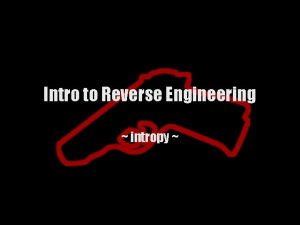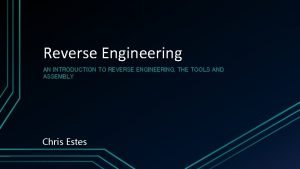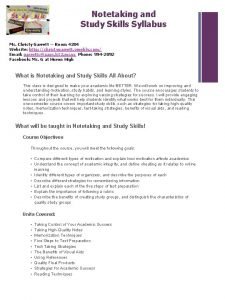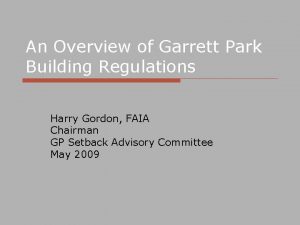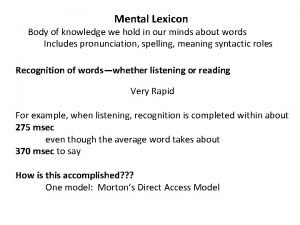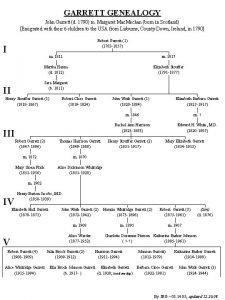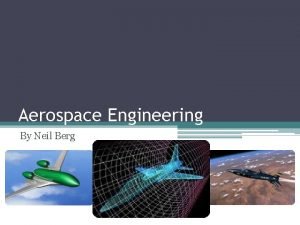AEROSPACE Garrett Fuller Intro to aerospace engineering Aerospace











- Slides: 11

AEROSPACE Garrett Fuller

Intro to aerospace engineering � Aerospace engineers are responsible for the research, design and production of aircraft, spacecraft, aerospace equipment, satellites and missiles. Work done by aerospace engineers has made such things as speedy mail delivery and moon travel possible. Canadian aerospace engineers designed the Canada-arm used on the Space Shuttle and Space Station Alpha.

EMPLOYMENT � Aerospace engineers held about 78, 000 jobs in 2002. Most worked in the aerospace product and parts manufacturing industries. Federal Government agencies, primarily the U. S. Department of Defense and the National Aeronautics and Space Administration, provided 10 percent of jobs. Despite the expected decline in employment, favorable opportunities are expected for aerospace engineers through 2012 because the number of degrees granted in aerospace engineering has declined greatly over the last decade due to the perceived lack of opportunities in this occupation.

$ALARY WAGE$ Bachelor degree candidates: starting salary $48, 028 a year Master’s degree candidates: start at $61, 162 a yr. Ph. D. candidates were offered $68, 406 a yr.

ENGINEERED AIRCRAFT MODEL An aerospace engineer designs and supervises the construction of aircrafts and associated parts such as airframe, auxiliaries, communication equipment, controls, fuselage, and powerplant. Analyzes results of stress tests on various aircraft and missile parts and conducts research to determine flight characteristics

NASA � One of the primary concerns of aerospace engineering is the development of aircraft that can withstand extreme physical and environmental conditions, including those which vary widely from the natural conditions on Earth. Extreme heat and cold, atmospheric pressures, and the difference in gravitational pull are only a few of the many considerations which aerospace engineers must contend with. They must also deal specifically with equipping vehicles for sustaining life inside them. One of the reasons NASA has yet to send a manned mission to Mars is that technology has not yet produced a viable contained environment which can sustain human life long enough during space travel from Earth to Mars. To successfully produce flight vehicles which can travel safely, both in and outside of the Earth’s atmosphere, aerospace engineers must be experts in a variety of scientific and technological disciplines, including aerodynamics, avionics, materials science, and air and spacecraft propulsion.

University of Michigan � The Department of Aerospace Engineering at the University of Michigan has, since its inception, been recognized as one of the leading Aero departments in the country. Throughout our nearly 100 -year history, our educational and research activities have been organized around advancing and teaching the essential elements associated with air and space vehicles, vehicle systems, and their associated technologies.

American Society for Engineering Education (ASEE) � � Is a non-profit member association, founded in 1893, dedicated to promoting and improving engineering and engineering technology education. In pursuit of academic excellence, ASEE develops policies and programs that enhance professional opportunities for engineering faculty members, and promotes activities that support increased student enrollments in engineering and engineering technology colleges and universities. Strong communication and collaboration with national and international organizations further advances ASEE’s mission.

Project Lead The Way (PLTW) � � Project Lead The Way is a not-forprofit organization that promotes pre-engineering courses for middle and high school students. PLTW forms partnerships with public schools, higher education institutions and the private sector to increase the quantity and quality of engineers and engineering technologists graduating from our educational system. Project Lead The Way seeks to create dynamic partnerships with our nation's schools to prepare an increasing and more diverse group of students to be successful in engineering, engineering technology and biomedical science programs.

JUNIOR ENGINEERING TECHNICAL SOCIETY(JETS) � JETS provides programs and resources that let students explore, assess, and experience engineering first-hand. From exciting student competitions to assessment tools and career exploration materials, JETS provides multiple pathways for students to discover their potential for engineering.

He says “We need young people to decide if they want to be an engineer, instead of wanting to be an investment banker, a scientist, a doctor or a teacher. ” Obama’s view on engineering
 Windows reversing intro
Windows reversing intro Introduction to reverse engineering
Introduction to reverse engineering Garrett wolfe duke
Garrett wolfe duke Study skills syllabus
Study skills syllabus Garrett morgan
Garrett morgan Garrett's model of speech production
Garrett's model of speech production Marsha garrett middlesbrough
Marsha garrett middlesbrough Garrett portable buildings
Garrett portable buildings Jesse james garrett visual vocabulary
Jesse james garrett visual vocabulary Garrett motion
Garrett motion Garrett lee smith grant
Garrett lee smith grant Lexical ambiguity examples
Lexical ambiguity examples
